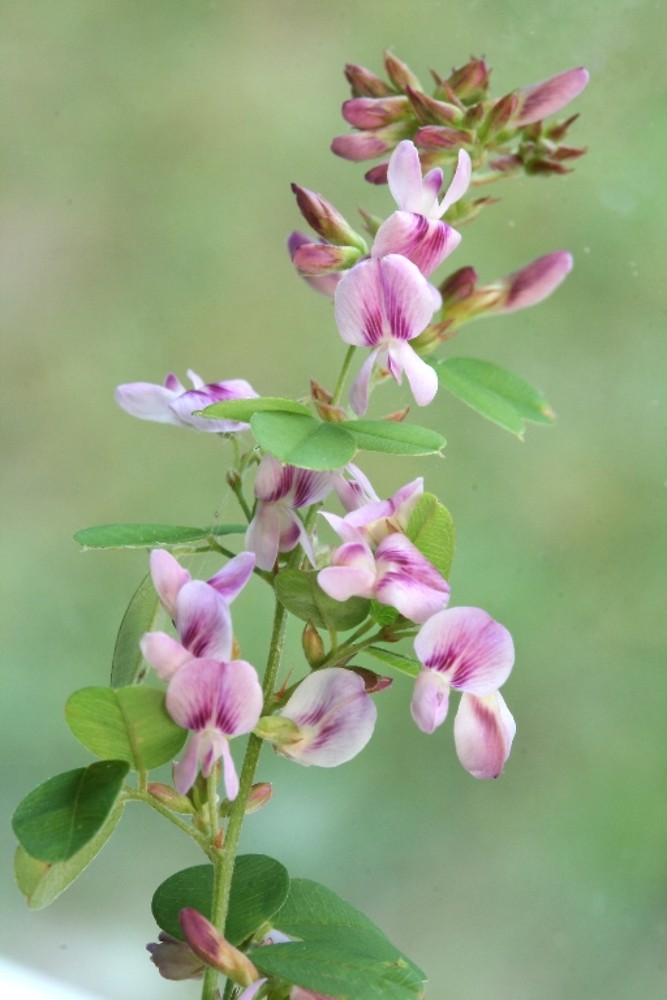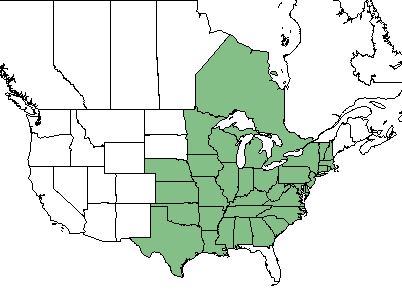Lespedeza violacea
Common name: violet lespedeza[1], wand lespedeza[2]
| Lespedeza violacea | |
|---|---|

| |
| Photo by Arieh Tal of Botphoto.com | |
| Scientific classification | |
| Kingdom: | Plantae |
| Division: | Magnoliophyta - Flowering plants |
| Class: | Magnoliopsida - Dicots |
| Order: | Fabales |
| Family: | Fabaceae |
| Genus: | Lespedeza |
| Species: | L. violacea |
| Binomial name | |
| Lespedeza violacea L. | |

| |
| Natural range of Lespedeza violacea from USDA NRCS Plants Database. | |
Contents
Taxonomic Notes
Synonyms: L. intermedia (S. Watson) Britton[2]
Varieties: none[2]
Description
L. violacea is a perennial forb/herb of the Fabaceae family native to North America and Canada.[1]
Distribution
L. violacea is found in the eastern half of the United States excluding Florida, as well as the Ontario region of Canada.[1]
Ecology
Habitat
L. violacea proliferates in woodlands and woodland borders[2], and predominantly in lowland sites.[3] Specimens have been collected from limestone outcrop, second growth of black oak area, cedar bluff woods, sandy soil of upland oak-hickory forest, open oak woods, sandstone quarry, shaded roadside, river bank, old field scattered with trees, bluff above floodplain, burned over pine region with clay soil, and bottomland hardwood.[4]
Phenology
L. violacea has been observed to flower from July through September and fruit from August to November.[2]
Conservation, cultivation, and restoration
L. violacea is listed as rare by the New York Department of Environmental Conservation Division of Land and Forests, and as threatened by the Vermont Department of Fish and Wildlife Nongame and Natural Heritage Program.[1]
Cultural use
Photo Gallery
References and notes
- ↑ 1.0 1.1 1.2 1.3 USDA Plant Database https://plants.usda.gov/core/profile?symbol=LEVI6
- ↑ 2.0 2.1 2.2 2.3 2.4 Weakley, A.S. 2020. Flora of the Southeastern United States. Edition of 20 October 2020. University of North Carolina at Chapel Hill, Chapel Hill, North Carolina.
- ↑ Towne, E. G. and K. E. Kemp (2008). "Long-term response patterns of tallgrass prairie to frequent summer burning." Rangeland Ecology & Management 61: 509-520.
- ↑ URL: http://herbarium.bio.fsu.edu. Last accessed: June 2018. Collectors: R.K. Godfrey, R. komarek, Robert Thorne, G.W. Parmalee, Andre Clewell, Paul Redfearn, H. A. Wahl, Norlan Henderson, George Jones, Norlan Henderson, Sidney McDaniel, Dick Houk, V. Muehlenbach, Sidney McDaniel, Norman E. Hill. States and counties: Florida (Leon) Georgia (Grady) Virginia (Giles) Michigan (Jackson) Indiana (Brown, Monroe, Martin) Missouri (Johnson, Osage, Platte, Jackson, Barton, St. Clair) Mississippi (Chickasaw, Tallahatchie, Holmes, Madison) Alabama (Cleburne, Calhoun)